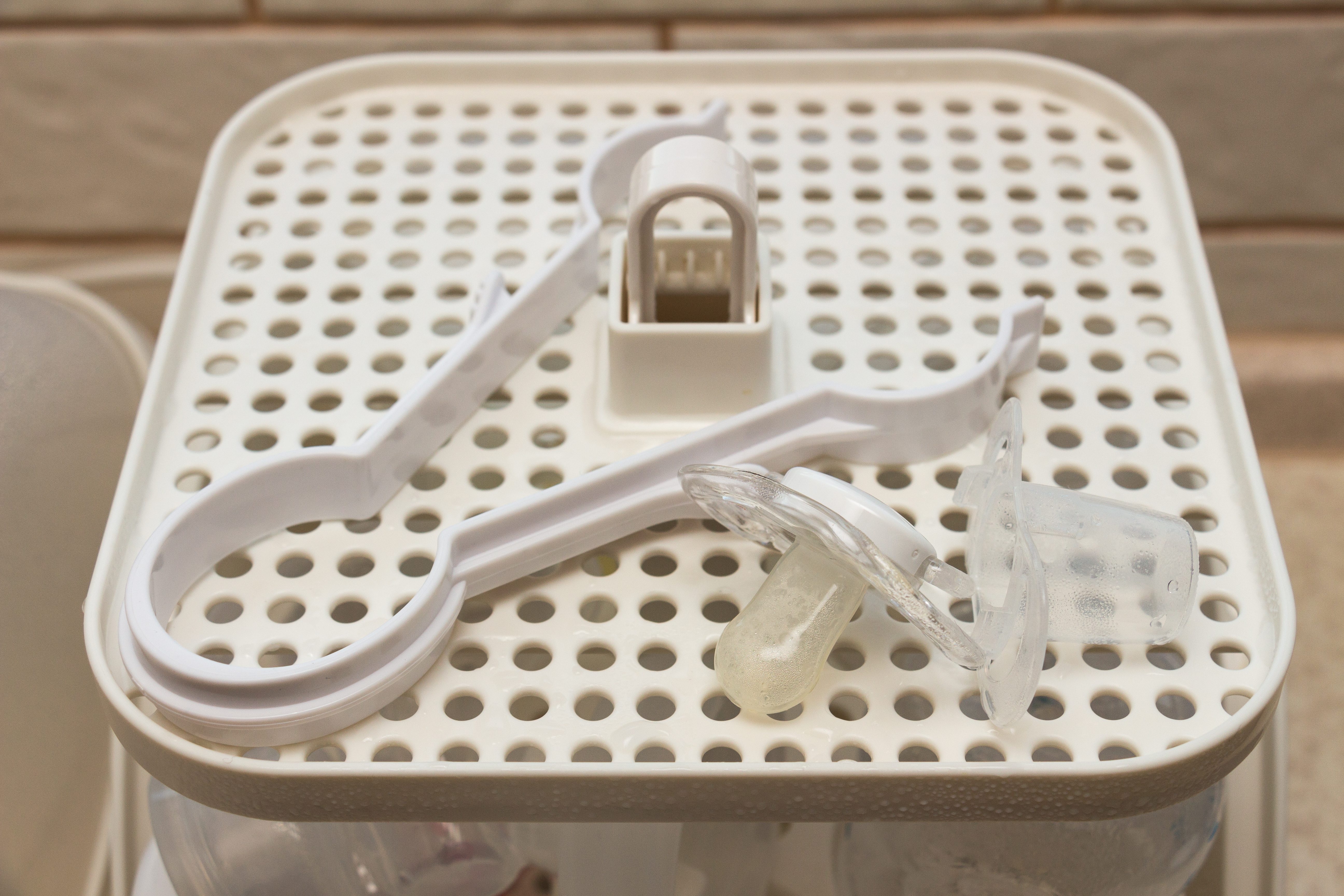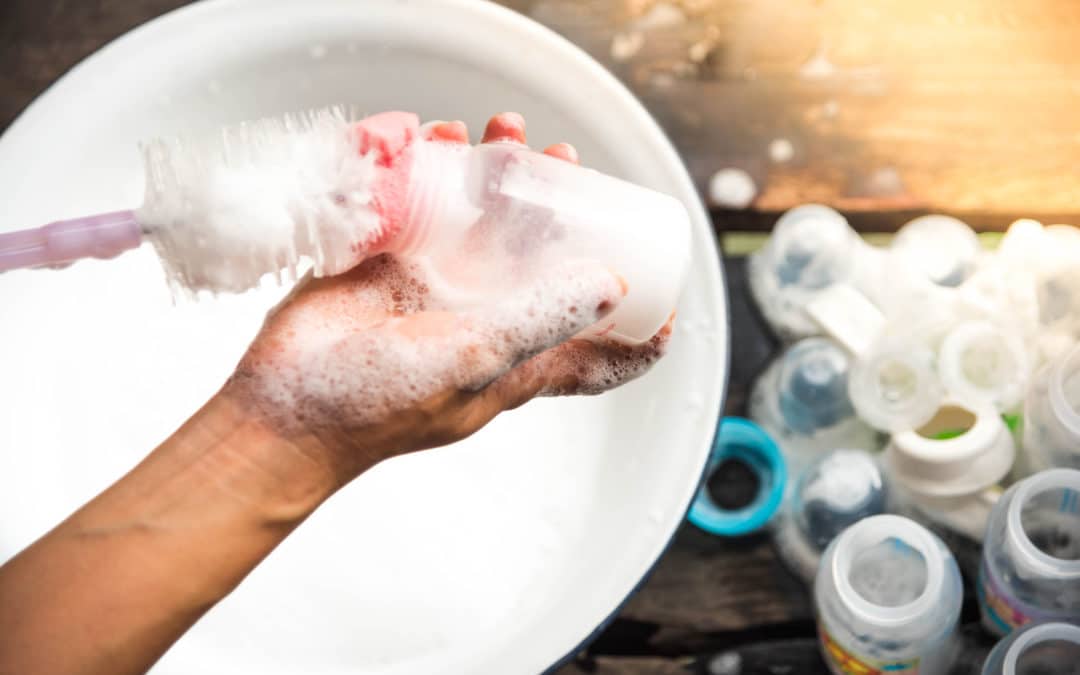
Read time: 3.5 minutes
TL;DR
- One important way to help keep germs away from your little one is by cleaning your baby’s bottles and your breast pump parts regularly in order to keep bacteria from growing.
- It is not possible to completely sterilize items using at-home methods, but they can help to remove most of the germs and bacteria.
- Unless recommended by your baby’s doctor, it is only necessary to sterilize bottles before they are first used.
- There are four main methods for sterilizing: boiling method, electric sterilizing, UV and cold water.
- Only the items that come into contact with your breast or breast milk need to be sterilized.
- To regularly clean bottles and breast pump parts, simply submerge in hot, soapy water and rinse with hot water, allowing the parts to air dry. Most bottle components and breast pump parts can also be regularly cleaned using the top rack of a dishwasher.
Your new little one’s immune system is still developing, so it’s important to keep as many germs away from him or her as possible to avoid illness. One important way to do this is by cleaning your baby’s bottles and your breast pump parts regularly in order to keep bacteria from growing.
After you open up your breast pump for the first time, you may look at all of the tubes and parts and wonder how you are going to keep them clean. Fortunately, cleaning and sterilizing bottles and breast pump parts are fairly simple.
What is Sterilization?
Sterilization is a process that removes germs and bacteria from an item. It is not possible to completely sterilize an item using at-home methods; however, sterilizing an item at home will remove most of the germs and bacteria from an item.
Is Sterilization Necessary?
You should always sterilize all bottles, pacifiers and breast pump components before they are first used by your baby. After this, your baby’s doctor may recommend additional sterilization if:
- Your baby or others in your household have been sick with a bacterial infection or a virus
- Your baby was born prematurely
- Your baby has a condition that has weakened his or her immune system
How Often Should Bottles and Breast Pump Parts Be Sterilized?
Unless recommended by your baby’s doctor, it is only necessary to sterilize bottles before they are first used. If your baby was born prematurely or has a weakened immune system, your doctor may recommend sterilization after every time you use your breast pump or feed your little one a bottle.
It’s important to note that only the items that come into contact with your breast or breast milk need to be sterilized. Tubing for closed system pumps like Ameda’s doesn’t typically come into contact with breast or milk, so it is not necessary to sterilize or clean the tubing. Should some condensation appear in the tubing after you pump, simply continue to run the pump for a few minutes after you are finished pumping until the droplets dry.
How to Sterilize and Clean Bottles and Breast Pump Parts
There are four main methods to sterilize bottles and breast pump parts: boiling, electric sterilizers, UV sterilizers and cold water sterilizing solutions.
Boiling Method
Bring a large pot of water to a rolling boil. Using a pair of kitchen tongs, carefully lower all of the breast pump and bottle components into the boiling water. Allow the components to boil for five to 10 minutes or as recommended by your child’s doctor. Carefully remove the bottles and breast pump parts from the water, making sure you don’t touch any part that comes into contact with your breast or milk with your hands or tongs. Allow to air dry.
Because the boiling water can damage the nipples of a bottle over time, it’s important to inspect the nipples before each use to ensure they are safe for your little one to use.
Electric Sterilizing Method
Counter-top electric sterilizers use hot air and water to create steam, which sterilizes the bottle and breast pump components. Many models will also deodorize and dry the different parts using hot air. When using an electric sterilizer, make sure that it is FDA-approved for sterilizing and that all of the parts that come into contact with your breasts or milk are facing down on the sterilizer.
Microwave steamers are not currently approved by the FDA for sterilizing. After cleaning, a microwave steamer can be used to sanitize the bottles and breast pump components.
UV Sterilizing Method
Ultra-violet light has been used for several years to remove the mold, bacteria and viruses in water. Recently, this technology has crossed over into baby products. Right now, UV sterilizers are only big enough to sterilize the nipple of a bottle or a pacifier, which doesn’t make them an ideal option for sterilizing an entire bottle or breast pump components.
Cold Water Sterilizing Method
If you aren’t able to use a steam sanitizer or boil water for sterilizing while you are traveling, it’s possible to still sterilizer your little one’s bottles and your breast pump parts with cold water. Sterilizing tablets are available that can be placed in a food-safe container with water that will sterilize your little one’s items.
Once dissolving the tablets in the water, simply submerge your bottles or breast pump parts completely. Follow the directions on the tablet container for instructions on how long to leave the components in the water. Once the correct amount of time has lapsed, simply rinse the components and allow them to air dry.
Cleaning Bottles and Breast Pump Parts Without Sterilizing
Fortunately, it isn’t necessary to sterilize your little one’s bottles and your breast pump parts after each use unless directed by a doctor. To regularly clean, simply submerge the bottles and breast pump parts in hot, soapy water. Rinse with hot water and allow the parts to air dry. Most bottle components and breast pump parts can also be regularly cleaned using the top rack of a dishwasher.
Sterilizing your breast pump and your little one’s bottles may seem a little daunting at first. It’s a simple step that can help keep your little one healthy as his or her immune system develops. Always check with your child’s doctor before discontinuing sterilization and always check for any cracks in your little one’s bottle nipples before use.


 Complete Our Simple Online Form
Complete Our Simple Online Form We’ll Handle All The Paperwork
We’ll Handle All The Paperwork Receive Your Free Ameda Pump
Receive Your Free Ameda Pump